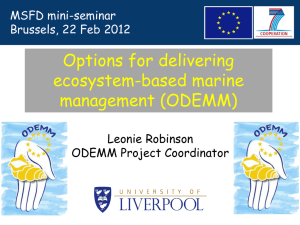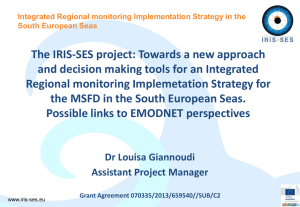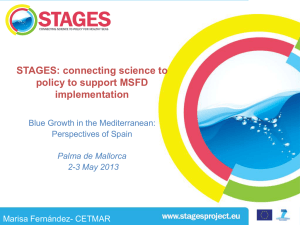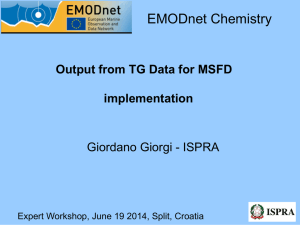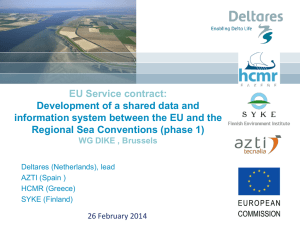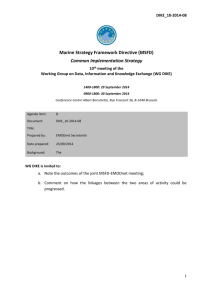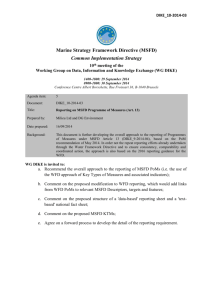EMD_CHEM_WP5_JUNE012014
advertisement
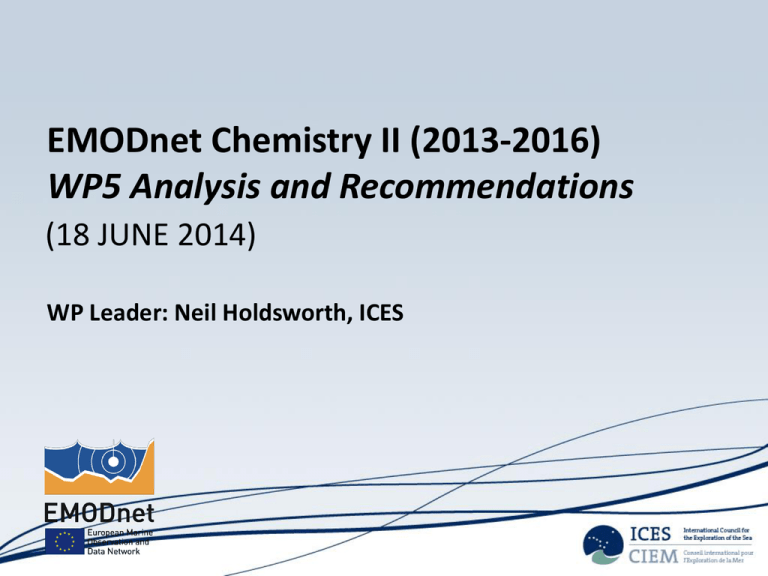
EMODnet Chemistry II (2013-2016) WP5 Analysis and Recommendations (18 JUNE 2014) WP Leader: Neil Holdsworth, ICES BACKGROUND: Who’s pulling the strings... DG-MARE (Maritime Affairs) DG-ENV (Environment) & EEA Blue growth Blue technology Shipping Wind/Wave energy Fisheries and Aquaculture Effect of pressures from exploitation Impacts on environment of human activity Intrinsic value of environment BACKGROUND: and the tools they have... DG-MARE (Maritime Affairs) Data Collection REVISION OF THE CFP Framework (DCF) and Future data provision will DC-MAP have a relation to Marine Knowledge 2020 EMODnet but also others EMODNET DG-ENV (Environment) & EEA INSPIRE Marine Pilot Water and Marine (2014) Framework Directive (WFD/MSFD) Habitats, Bathing water etc. Directives INSPIRE (Public body spatial data) WISE and WISE-Marine EMODnet Chemistry II (2013-2016) WP5 Analysis and Recommendations WP description: inputs • Specific MSFD feedback through WG-DIKE and TG DATA • Gather feedback from ENV 2012/11 “Sea basin Checkpoints” • Feedback from Chemistry project partners including data providers • Overall EMODNet strategy developments at EU and Member States levels EMODnet Chemistry II (2013-2016) WP5 Analysis and Recommendations WP description: objectives • Engage with MSFD stakeholders and align/revise chemical portal and products through dialogue • identify key users and report on the effectiveness of the system in meeting the needs of end-users • provide a summary feedback to the products work package (WP3) • To establish efficient tools to obtain users feedback EMODnet Chemistry II (2013-2016) From DOW calculate spatially distributed data products specifically relevant for Marine Strategy Framework Directive Descriptors 5 (eutrophication), 8 (chemical pollution) and 9 (contaminants in seafood)1 based on guidance provided by the Marine Strategy Framework Directive Common Implementation Strategy2 1) Role of Regional Sea Commissions (RSC’s) - Commission has clarified since the drafting of EMODnet II tenders - Expectation to use/adapt existing data products/indicators 2) MSFD CIS* - A series of papers developed and agreed through Commission working groups - Have implicit member state acceptance through marine directors - Provide guidance but not specifics on the ‘how to’ Data –> Information flow for MSFD (coordinated) Monitoring [National] and [Regional Data provision bodies] Data assembly (products) Ingestion Indicator provision data information Regional Conventions and EEA Assessment product(s) knowledge TG DATA (Jul. 2013, Apr. + Sep. 2014) - WISE-Marine ‘knowledge’ mapping proposal template Assessment WG-GES Indicators WG-DIKE Data assembly Data Collection (sources of observations) TG DATA (Jul. 2013, Apr. + Sep. 2014) Region: MSFD Region/Subregion(s) ASSESSMENT INDICATOR(S) DATA ASSEMBLY DATA COLLECTION (sources of observations) Descriptor: MSFD descriptor Decision basis - - - Reference to national assessment(s) and when Reference to national Reference indicator(s)to regional assessment (RSC or other i.e Data not assembled beyond national Reference to RSC indicator ICES) scope References Commission Reference totoEuropean Data assembled under RSC -decisions/MSFD related assessment Regional sea monitoring o References to RSC working group and decisions programme(s) regional bodies/committees/process Reference to Baseline es coordination national References toofother assessment/Commission programmes o References to directives/frameworks (i.e. decisions institutes/organisations that DCF/DCMAP, habitats Member state monitoringwork carry out/sub-contract directive) programme(s) o - - References to methodologies/reports Member state data sourcethat outline assembly method provision (institutes, or central distribution point Data assembled under EU project/EU infrastructure o o o Operational basis Description of assessment product Linkages to indicators: Appropriateness for WISELocation/Availability Marine output Not applicable New/Existing provision Adaptations needed Linkages to assembled data Supporting information Assessment scale MS provision mechanism(s) o data Location/Availability Frequency of provision Temporal scale o Usage Availability o rights Spatial unit (related to MSFD o o Update Usage frequency rights units) o o Format/Outputs Update Context of use frequency (consistency with o Metadata MSFD scope) o Format/Outputs o Spatial unit o QC applied o Spatial unit o Metadata Mechanism(s) to assembled data o Location/Availability o Operational portal/web service o Usage rights References to institutes/WP leaders/organisations that carry out/sub-contract work o Update frequency o Format/Outputs References to methodologies/reports that outline assembly method o Metadata o Spatial unit o QC applied Linkages to RSC bodies/committees/process es MSFD key interactions (2013) - TG DATA: Specific agenda placeholder for input from EMODnet Chemistry ” How can Emodnet (chemistry) engage in support to MSFD data reporting” MSFD key interactions (2014) MSFD 8.1.1 :Concentration of the contaminants mentioned above, measured in the relevant matrix (such as biota, sediment and water) in a way that ensures comparability with the assessments under Directive 2000/60/EC Hazardous substances in water WFD priority substances (2008/105/EC, 2013/39/EC) Alachlor Anthracene Atrazine Benzene Brominated diphenylethers Cadmium and its compounds Chloroalkanes, C 10-13 Chlorfenvinphos Chlorpyrifos (Chlorpyrifos-ethyl) 1,2-dichloroethane Dichloromethane Di(2-ethylhexyl)phthalate (DEHP) Diuron Endosulfan Fluoranthene Hexachlorobenzene Hexachlorobutadiene Hexachlorocyclohexane Isoproturon Lead and its compounds Mercury and its compounds Naphthalene Nickel and its compounds Nonylphenols Octylphenols ( 6 ) Pentachlorobenzene Pentachlorophenol OSPAR HELCOM UNEP/ BSC MAP WFD priority substances (2008/105/EC, 2013/39/EC) x x Polyaromatic hydrocarbons (PAH) ( 7x) x Simazine x Tributyltin compounds x x Trichlorobenzenes x Trichloromethane (chloroform) x Trifluralin x x Dicofol Perfluorooctane sulfonic acid and its derivatives (PFOS) Quinoxyfen Dioxins and dioxin-like compounds x Aclonifen Bifenox Cybutryne Cypermethrin ( 10 ) Dichlorvos Hexabromocyclododecanes (HBCDD) Heptachlor and heptachlor epoxide Terbutryn Carbon-tetrachloride x DDT total x para-para-DDT x x Aldrin x x Dieldrin x x Endrin x x Isodrin x x Tetrachloro-ethylene Trichloro-ethylene x x x x x x x x x x x x x x x x x x x x x x x x x x x x x x x x x x x x x x x x x x x OSPAR HELCOM UNEP/ BSC MAP x X denotes reporting % of CPs reporting 100-81% 80-61% 60-41% 40-21% 20-1% x x x x x x no reporting MSFD key interactions (2014) MSFD 8.1.1 :Concentration of the contaminants mentioned above, measured in the relevant matrix (such as biota, sediment and water) in a way that ensures comparability with the assessments under Directive 2000/60/EC Hazardous substances in biota WFD priority substances (2008/105/EC, 2013/39/EC) OSPAR HELCOM UNEP BSC /MAP Alachlor Anthracene x Atrazine Benzene Brominated diphenylethers x Cadmium and its compounds x Chloroalkanes, C 10-13 Chlorfenvinphos Chlorpyrifos (Chlorpyrifos-ethyl) x 1,2-dichloroethane Dichloromethane Di(2-ethylhexyl)phthalate (DEHP) Diuron Endosulfan x Fluoranthene x Hexachlorobenzene x Hexachlorobutadiene x Hexachlorocyclohexane x Isoproturon Lead and its compounds x Mercury and its compounds x Naphthalene x Nickel and its compounds x Nonylphenols Octylphenols ( 6 ) Pentachlorobenzene x Pentachlorophenol x x x x x x x x x x x x x x x x x x x x x x x x x x x WFD priority substances (2008/105/EC, 2013/39/EC) OSPAR HELCOM UNEP BSC /MAP Polyaromatic hydrocarbons (PAH) x( 7 ) x x Simazine Tributyltin compounds x x Trichlorobenzenes Trichloromethane (chloroform) Trifluralin Dicofol Perfluorooctane sulfonic acid andxits derivatives x (PFOS) Quinoxyfen Dioxins and dioxin-like compounds x x Aclonifen Bifenox Cybutryne Cypermethrin ( 10 ) Dichlorvos Hexabromocyclododecanes (HBCDD) Heptachlor and heptachlor epoxide Terbutryn Carbon-tetrachloride DDT total para-para-DDT x x Aldrin x x Dieldrin x x Endrin x x Isodrin x x Tetrachloro-ethylene Trichloro-ethylene x X denotes reporting % of CPs reporting 100-81% 80-61% 60-41% 40-21% 20-1% x x x x x no reporting MSFD key interactions (2014) MSFD 5.3.2 Dissolved oxygen, i.e. changes due to increased organic matter decomposition and size of the area concerned Parameters used in DO MSFD art 8, 9, 10 reporting OSPAR x MSFD art 8,9, 10 x HELCOM x MSFD art 8,9, 10 x UNEP/MAP MSFD art 8,9, 10 x BSC x MSFD art 8,9, 10 x WiSe SoE [WFD, EEA]x Organic content BOD5 BQI MAMBI x x x x x x x x Anoxi COD Benthic a mortality x x x x X denotes reporting % of CPs reporting 100-81% 80-61% 60-41% MSFD art 8, 9, 10 reporting from Palialexis et al. 2014 40-21% 20-1% no reporting MSFD 5.3.1 EUTROPHICATION BSC reporting on phytobenthos species level taxonomy, phytobenthos species biomass, total biomass MSFD key interactions (2014) TG DATA D5 and D8 Workshop (April) - EMD Chem products workshop was advertised - Italy presented their use of EMD Chem - Discussion on future interaction between TG DATA and EMODnet MSFD key interactions (2014) TG DATA D5 and D8 Workshop (April) ” … could play a role in providing informational ‘state’ products, and as a reference point for understanding the general availability and distribution of data.” MSFD key interactions (2014) Specific EEA/DGENV workshop planned (September)* - Regional Data products compilation - Decentralised reporting * Difficult to get the right attendees to Split

